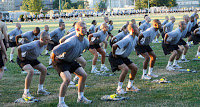Coach Education Improves Adherence to Anterior Cruciate Ligament Injury Prevention Programs: A Cluster-Randomized Controlled Trial. Clinical Journal of Sport Medicine
Ling, Daphne I; Boyle, Caroline; Schneider, Brandon; Janosky, Joseph; Kinderknecht, James; Marx, Robert G. Clin J Sport Med. July 2022 – Volume 32 – Issue 4 – p 348-354. doi: 10.1097/JSM.0000000000000936
Take-Home Message
Coaches who received education on anterior cruciate ligament (ACL) injury prevention programming were more inclined to include it in their warm-up. In-person training sessions increased the use of appropriate alignment cues and inclusion of a complete prevention program.
Background
Neuromuscular training programs can decrease an athlete’s chance of an ACL injury and be incorporated as a simple warm-up. However, few coaches use injury prevention warm-up programs.
Study Goal
Ling and colleagues completed a cluster randomized controlled trial to examine if live educational training for coaches with take-home documents led to better adherence to a neuromuscular training program for their teams than coaches only receiving program information via email.
Methods
The authors recruited coaches through an email to athletic directors at high schools with which the authors’ institution had affiliations. The authors excluded schools that had previously implemented a neuromuscular training warm-up program. High schools interested in participating in the study were randomized to receive live education for coaches with reference documents or just educational documents. Coaches from schools randomized to the intervention attended a live education session and received a video for reference and follow-up documents for a series of neuromuscular training warm-up routines (beginner to elite) incorporating 7-10 exercises. Coaches from schools in the control group only received the documents in an email. Trained data collectors observed all teams 2-3 times a week at both practices and games. They checked if coaches implemented the neuromuscular training exercises, provided instruction on proper execution, and offered proper alignment cues for technique.
Results
The authors randomized 8 high schools, which included 21 teams. Throughout two seasons, the data collectors observed 399 practices or games and 2579 exercises. Coaches in the intervention group used ~7 exercises per session, whereas coaches in the control group only used ~6. More coaches in the intervention completed a full neuromuscular training warm-up program and provided alignment cues to correct improper techniques than coaches that only received the documents.
Viewpoints
As I would suspect, the findings of this study support educating coaches on proper techniques and exercises in a live format. The authors used a combination of lecture and hands-on skill training during a 1-hour education session. Completing this education session allowed coaches to ask questions, gain clarity, and better understand the need to implement the program properly and throughout the entire season. Having data collectors periodically on-site throughout the seasons may have made coaches more compliant. However, coaches did not know when the data collectors would be present, lending validity to the data in that coaches were not just performing the prevention exercises in a performative manner because they thought they were being watched. It would be interesting to see if this educational session would help coaches at more high schools and if other educators could effectively provide this educational session.
Clinical Implications
Clinicians should arrange educational workshops for coaches to help them adopt proven ACL injury prevention programs as a part of their warm-up routine. These workshops could be delivered by the clinician, another local healthcare professional, or a coach with experience using these programs.
Questions for Discussion
Would the implementation of exercises be higher if coaches could self-select from a group of beneficial exercises for their team, hence increasing “buy-in”?
Would governing bodies approving programs and recommending coaches’ education of these programs specific to their sport increase adherence and proper execution or discourage participation?
Written by Shelly Fetchen DiCesaro
Reviewed by Jeffrey Driban
Related Posts
Sports Injury Prevention Programs Stretch A Player’s Money
Sending Injury Prevention Programs Back to School
Forget about 7-minute Abs. How about the 10-Minute Lower Extremity Injury Prevention Program?



I think this is very important especially when we as clinicians want to limit injuries that can be season and even career ending. Having the capability to teach coaches and even have them implement prevention to their athletes. One thing I am curious about is the difference between the two groups. The only difference that was stated the number of exercises as 7 for the test group and 6 for the control group. Was it just one exercise that made a difference? I do think that if the data supports the use of the prevention warm up then more schools should implement it. As a future athletic trainer I think it would be good to use this prevention program